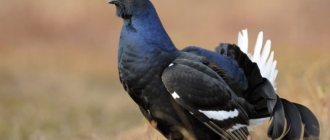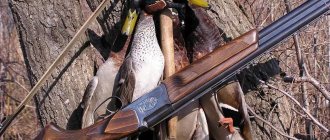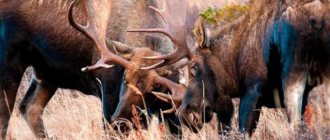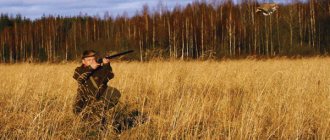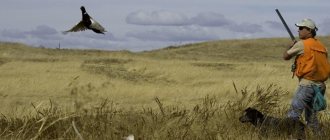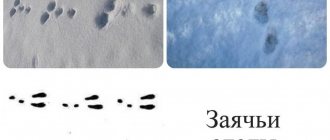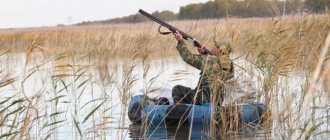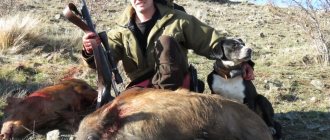Catching wild animals is divided into three levels of difficulty, depending on the weight and aggressiveness of the animal, the subtlety of its killing, the difficulty of tracking and capturing. The hardest type of fishing is considered the most difficult category. This is what moose hunting refers to.
The elk is a huge, tall and heavy animal. It stands at the top level of the family of deer species of flora. Has powerful hooves and horns. He needs all this to repel natural predators. For hunters, elk is not an easy, dangerous prey. But the stubborn shooter does not give up. His insides are aroused by an even greater “fire” of excitement, the interest of a mad genius, if he has to work in a fight against a difficult animal breed. The heavier the animal, the more difficult it is to defeat it - the more burning the desire of the catcher.
Elk - description and habitats
The average adult animal weighs almost half a ton, and its skin is thick and durable. It can only be used to make shoes or outerwear - such things will not be demolished.
The horns are like the wide bucket of an excavator. They are united in their roots, dividing towards the top. This is his pride. Only males wear them. Females without such decoration. When young, the male animal bears small horns. Raises them to adulthood. Afterwards, horn growth continues from spring until late winter. During the snowy season, the deer sheds its antlers. Then it grows a new “crown” again.
In healthy adult males, mature antlers reach a weight of up to twenty-five kilograms.
People love to give each animal their own nickname. Many people call boars cleavers, and hares – scythes. Everything comes from analogies between a person and different objects. The moose got a nickname - “sokhatyy”. From a simple peasant plow, a farmer's tool. The analogy of horns is the reason for the nickname.
The crowned giant received naturally long legs, “shod” with powerful hooves, and a wide, heroically wide chest.
The body, in proportion to the legs and chest, is small, awkward, and tapers towards the pelvic area. The muzzle is wide, large, located on a short neck with a small hump on top - natural cartilage. The same cartilage is found on the nose.
The eyes are small and do not see very well. But he tries to compensate for this deficiency with acute hearing and a sensitive sense of smell. Mostly successful.
The undercoat is fluffy, warm, and provides good protection in winter. The outer coat is dense, in fine bonds with a coarser undercoat. The elk has a mane from the back of its head to its chest. The mane fur is dark and thick. Sometimes it seems that the elk is not wearing natural fur on its chest, but a scarf that someone has intricately tied on its long, large body.
The shade of the main coat varies from summer to winter, but retains a dark reddish color. When the molt passes, it becomes somewhat lighter in winter. In hot forest summers it turns brown and black throughout the outer cover.
Mother Russia is rich in all kinds of living creatures. In the vastness from the Far East to the western European shores, the country is inhabited by animals.
Moose successfully breed their population in this area. Reproducing without interference or additional habituation. They do not have a pause for crisis adaptation of the family. This animal also lives in America. North America is home to the number two long-legged herbivore species of deer.
The elk have only one habitat – wooded areas. As many forests as possible in your surroundings. It is associated with a pathological fear of a predator capable of defeating him, as well as with the temperature regime of his body.
And in the hot summer comes the season of hell and devils for the moose. If he didn't cover his insides in a wet area. A coniferous or deciduous forest shelters the animal from the heat. The proximity of bodies of water, swimming in them too.
Moose meals are balanced and frequent. The regime of alternating feeding and rest is maintained.
As for plant food, the giant is ready to feast on many types of flora. About 800 categories of plants and trees.
If an animal experiences power interruptions, its behavior sharply increases irritability. Nervous, twitchy deer are a factor in the hunger of their species.
The forest giant feasts on the shoots of coniferous trees, often succulent foliage, and their branches. Gnaws the trunks of aspen, rowan, and willow trees. Long lips on its muzzle with keratinized skin at the ends allow the elk to eat pasture, gnaw at knots and snags without the risk of damaging the oral cavity, or scratching the inner palate and gums.
If such a powerful animal has a wild appetite, then it is easy to think that the elk will spend considerable time at the watering hole.
Animals cannot obtain food in harsh conditions. Frequent migrations across the habitat. In the middle of the autumn-winter season, if the cold period begins with heavy precipitation, the moose are removed from their place. Move to a less snowy area. There it is more comfortable for the animal to walk on long legs - there are no deep snowdrifts. Food does not need to be obtained through hard labor.
An amazing fact is moose in the water of streams or rivers. There, diving, they grab algae from the bottom and feed on them. While searching for river grass, artiodactyls can hold their breath underwater for several minutes.
They are forced to get into the water in the summer to escape mosquitoes, mosquitoes, and other flying parasites. In combination with the animal's sweat, they cause wild troubles on land. Water helps to momentarily relieve the itching of insect bites throughout the giant body.
Habits of the beast
Moose laziness in terms of movements and walking is something interesting and not entirely stupid. A long gait is not for the elk breed; choosing a specific place to lie down, with its own set of advantages or conditions, is also not for him.
Yes, and the large horned individual does not like to walk a lot, and does not arrange its main rookeries. But all these moments do not mean that his behavior has no meaning at all and he doesn’t care about anyone. No. As long as there is available pasture or wood food within its reach, the elk is happy with everything. Regularly alternates small portions of feeding and rest. It doesn’t make much difference whether it’s a swampy area underneath or a forest clearing – he lay down where he lay down to rest. He carries out existence without unnecessary waste of body energy. If the climate allows, the elk lives on a patch of 1-2 hectares of land for up to four weeks. Afterwards, he reluctantly changes the situation, walking 1-2 kilometers. Continues his lifestyle there. Time is spent on food and rest evenly.
It seems that with this behavior, elk are an easy and large prey. A lazy person will get shot quickly and easily. There will be those who want it. But no. In quiet mode, for an elk, moving across terrain over a distance of 1-2 km is heroic movement. In a dangerous situation, he easily covers long distances of 30-40 km. At the same time, moving on long legs at a far from slow speed.
He is not shy, not complex; on the contrary, the moose has more than enough self-confidence. In a hurry, he is able to move through obstacles, his dimensions allow him.
In the area, individuals try to stay alone. Rarely do individuals travel collectively. As a rule, this is the mother of an elk family, with a brood.
They have a somewhat willful or slightly stubborn character when moving to another habitat. If he doesn’t want to start running, he will continue to walk at a measured pace until the end of the journey. If there is an urgent need, he will immediately take off. At the same time, gain a good speed for the moose.
It turns out that the animal can do a lot, knows how, but it does it when it wants to do it. Or, when a powerful external factor acts, such as natural weather, danger to life. In such a unique world of their own, in the wild, the life expectancy of male moose is from 10 to 15 years. In captivity, the life of an elk is somewhat different from the natural environment. There he fails to demonstrate many habits and stubborn actions. But there is also less stress and danger. This fact has a beneficial effect on the life expectancy of moose - moose live in pens for a quarter of a century.
Due to their habits of living in the wild, the elk shortens its life due to natural predators - wolves, lynxes. Especially in cold weather, the elk is weaker than usual, and there is no food within easy reach. Lynxes and wolves can be extremely hungry. Sometimes a sensitive sense of smell or keen hearing cannot save moose - predators in packs act quickly and accurately.
The surprise attack factor and common efforts defeat stubborn loners. Wolves even have effective attack tactics. Carefully creeping very close to the elk, they rush at the animal's carcass with lightning speed from the rear or in a jump from above. They target the vital veins on the elk's neck with their fangs. They gnaw through the carotid artery, and the elk practically slowly fades away before our eyes.
Reproduction in moose
However, there is a period when the elk itself becomes angry, nervous, fast and excited. The beginning of autumn and for two months in a row then the mating season begins for the elk family - the rut. This is where the powerful horns of males come in handy. At this time, the elk is not himself, makes guttural intermittent sounds, is pugnacious and angry. It is better for a person not to meet a moose on his way to these games. Too dangerous.
Male moose try to stay in the habitats of females for two months. There is an accumulation of males. Finding out who will get the females begins. They have fights and fatal fights almost every day. Moreover, when there were more males to “marriage” than females. The opposite also happens, when some of the males are exterminated by a human hunter. There are already fewer males coming to the rut than females. Then one of the moose passes several females at once, giving each one offspring.
The female carries the calves for a long period - almost forty weeks. Mating games in elk families are mandatory. After wild fights between the males and finally having the opportunity to be with the “lady,” courtship and flirting begin. At the same time, the elk’s nervousness and irritability disappears instantly. The suitor plays the mating game until he receives a positive response from the female. Calmness towards the female does not eliminate aggression towards external stimuli. It is worth being very careful, especially for humans, as the elk is only affectionate with the moose cow during this period.
When is the best time to hunt?
An activity such as moose hunting can be attributed to the autumn-winter period. There are three main time periods into which Russian legislation divides this type of activity:
- shooting of adult males - from September 1 to 30;
- shooting of all age and sex groups - from October 1 to December 31;
- hunting for young animals up to one year old - from January 1 to January 15.
In Ukraine, hunting dates are more vague, but do not differ much from this classification - the season begins in August. Males of any age can be shot until January, while hunting of females and young animals is allowed only from September to December.
It is no coincidence that such measures were taken - in mid-autumn, moose go through their mating season, after which females bear offspring for seven to eight months.
However, autumn and early winter are a golden time for hunters: at this time the hunting season for ducks, almost all ungulates, bears, foxes, wild boars and hares also opens.
Moose hunting dates
Moose fishing time is divided based on countries and their regions. The consideration of deadlines in this article is carried out exclusively for the Russian Federation. In other countries, the timing may be different.
Russia distinguishes three main periods of moose hunting with strict division and implementation.
Season "Adult Elk"
Starts from the end of August to the end of September. The hunting period is used when the elk enters the mating season. It becomes more dangerous and aggressive. Increased attentiveness, professional shooting skills and hunter experience in heavy types of animal catching are required. Beginners to fishing during this period can only be admitted as safe observers from the outside. Another role in such fishing is too dangerous for health.
Season "Elk Any"
It is allowed to shoot any elk animal - male, female, calf. The most common hunting season for animals of this type. Takes place from the beginning of October to the end of December. During this period, the animal’s rut has already completed - the male returns to his usual behavior, and in the snow he becomes somewhat weaker. The second point is that the new generation, now somewhat stronger, wanders through the forests with their mothers. The popularity of the season is also associated with catching large horned animals using collective methods, such as a pen, or from an ambush. A lot of hunters are participating in the second season in their groups. In addition to shooting, there is a large flow of communication, exchange of experiences and news.
Season "Calves"
The modern innovation of prey stalking. Rich aristocrats became her active proteges. In their society, it is considered appropriate to kill practically defenseless moose calves. True hunters are indignant about the third season, do not use it themselves and are trying with all their might and possibilities to ban it at the legislative level. Currently, some of the work in this direction has already been carried out, but victory is not yet on the side of the real hunters.
Moose hunting with husky
Dogs are used when hunting elk in the following cases:
- Laikas are allowed to search during driven hunts, and they, together with the beaters, put the moose to numbers.
- The dogs, in a free search, find and begin to bark at the elk, delaying the animal and diverting its attention, which allows the hunter to approach the shot; the elk are almost not afraid of dogs and do not move away from annoying uninvited guests.
- Dogs are used to search for wounded animals; the dog’s task is to find, stop and hold a wounded elk until the hunter approaches. In the first case, they mainly use hounds and huskies; in the second and third options, of course, a better husky dog cannot be found, although there are supporters of the use of continental pointers.
What equipment and weapons should you use?
The main moose hunting seasons take place in winter, in the snow; clothing requirements are mandatory white camouflage. Otherwise, the requirements for clothing and additional equipment when hunting elk are the same as for other wild animal hunting.
Clothing and additional equipment
No foreign perfume odors, smoking and alcohol prohibited. A comfortable type of clothing from outerwear to literally underwear. No extraneous noise or distracting rustling. Fishing in winter - clothing should be as warm as possible. Protect the owner from wind and cold. Not torn and quite dense in thickness.
Shoes are of high quality tailoring, of the most closed type. No squeaks or unnecessary extraneous sounds. Lightweight and comfortable for the catcher. Any discomfort can cause harm just at the most important moment of the hunt.
In general, it is worth achieving maximum practicality, ergonomics and financial level of the average hand.
Weapon
The choice may be between single and double-barreled non-rifled barrel models. The double-barreled tool is highly popular due to its high durability in almost all types of hunting, changing only the caliber.
Hunters of average experience and finance use models of already rifled barrels in three class names: rifles, rifles and carbines. Universal cartridge for all three based on caliber - 9.3 mm
For hunting antlered elk, the tools have more shock power per charge by threading the barrel than any shotgun. One of the factors is to assign the first choice to newbies as trainees, and the last choice to hire experienced shooters. Shotguns with a notch in the barrel have their own characteristics, they must be taken into account when initializing and starting a campaign. Weapon models "Dacota76", "Berkut", the popular "Saiga".
Combi-system of weapon craft. The same firearm is allowed according to documents and hunter's cards.
Visually, rifled and smoothbore barrels combined in one convenient shooting tool. This option is very convenient for complex types of hunting, because:
- Upper smoothbore. To hit the animal at a close (up to 30m) distance without a ricochet, i.e., without fear of catching one of the people with a stray bullet at the time of collective shooting;
- Lower rifled barrel. The range and lethal force when firing are much higher. Cannot be used at close ranges. For safety reasons, there is an option to ricochet and hit a person.
Ammunition system. For the smooth-bore version, semi-jacketed bullets of the popular 9.3 mm caliber are used for short-range targets. For long-range rifled weapons, 338 win ammunition is used.
Something new is constantly appearing in the world. Hunting and weapons are no exception. It’s hard to believe, but hunting such large animals with a crossbow has recently become popular. The model is a compound swept crossbow. It is still fashionable to hunt with such weapons in the West. The tips are made in a curly shape. The alloy for arrows is unique. There is an optical sight. Requires mandatory target practice. Theory and practice before reality with a crossbow is mandatory.
Popularity is associated with novelty and exotic use. What attracts hunters is the noiselessness when shooting from such auto-bows. Arrows deliver piercing strikes. They hit vital organs with precise shots. Cutting wounds are inflicted. The consequence of such factors is heavy blood loss and the extinction of the animal on the spot.
Moose hunting in a pen.
Hunting in Russia has always been a traditional component of the national mentality. Moose hunting is a truly Russian event. Only a real hunter knows how much endurance and composure is required to achieve success. The elk is a large, strong animal, also smart, with good hearing and sense of smell, therefore, most often, a driven hunt for elk is organized, in other words, this is a collective event.
During one hunt, depending on the result, one, two or even three drives are arranged, so the hunting team gathers early in the morning, and the day before, as a rule, the location of the future drive, the number of numbers and beaters are agreed upon. The principle of driven hunting is quite simple: shooters are dispersed at the intended enclosure (the place where the elk should be), the shooter's ambush point is called a number, the beaters, those who move from the opposite side, must raise the animal and, making as much noise as possible, drive the future prey to the numbers , thus creating a corral ring, where the elk will be forced to move in a certain direction and go directly to the arrows.
The manner of behavior during a driven hunt is strikingly different between the numbered shooters and the beaters. The first must do everything to be invisible: you can’t smoke in your room, you can’t move much or talk even in a whisper, you can’t use perfume beforehand so that the animal doesn’t smell the smell, clothing should help camouflage on the ground. The beaters do exactly the opposite: they shout loudly, move actively, wear bright vests, and the beater’s bright vest makes it possible for not only the animal, but also the shooter to see the person, this is an important point of safety. If the drive is successful, the elk is found and raised, then further responsibility falls on the shooters; it is important to correctly calculate the distance, guess the direction where the elk might go, and choose the right moment to shoot. The accuracy of the shot and the accuracy of the hit depend on many factors: wind, air temperature, air humidity and the absence of interference; any twig caught in the bullet’s flight path can ruin all the work of the beaters; the animal will have the opportunity to simply leave the pen area.
It is worth noting that well-thought-out details of a group hunt may not always lead to success. An elk will never go with the direction of the wind, and if it is driven against the wind, it can easily smell the scent of shooters on the numbers and leave the enclosure unnoticed. But still, no matter how much you would like to get a hunting trophy, the shooter at the license plate must strictly follow the safety rules: the gun is loaded only at the license plate, you cannot shoot at a vaguely visible target, you cannot shoot along the line of other shooters, the commander’s command “release” means that The beaters came close and it was necessary to unload the gun.
Standing at a number and waiting for what will happen next seems like a boring task at first, but in fact it is very interesting. Silence in nature deserves to be heard, at this moment a person is given the opportunity to feel like a part of all its power, to merge with the surrounding space, and then amazing things happen: not only the one you came to hunt can come to you, because the beaters will disturb everyone who is currently on the territory, it could be a fox, a hare, a squirrel, an owl or another bird could fly from a branch. It happens that different animals come out to the shooters at the numbers, and what one saw, the other could not see, as a rule, such a development of events is heatedly discussed after the hunt, this is how hunting tales develop.
If for some reason the first drive was unsuccessful, the animal left or was not there at all, then after a short break the hunters move to another territory, a new corral ring is formed and everything starts all over again. When the enclosure area is large, hunters take dogs with them; the dog must find an animal that was mortally wounded, but was able to escape. A well-trained hunting dog should quickly detect a scent, even in bad weather conditions, and with a loud bark notify the hunters of the prey without leaving it.
For a driven round up of an elk, the husky is preferred; most of them are silent workers. Having discovered the animal, the husky begins to circle it, not allowing it to go far from the hunters, periodically letting the owner know where it and, accordingly, the animal are.
But now, the pen is organized correctly, the weather is appropriate and the handsome elk is out on the line, you can’t help but admire such a spectacle! Inexperienced hunters in such cases lose their cool and experience confusion: firstly, the elk is a really large animal, sometimes it can come unexpectedly close and scare, and secondly: if the elk has not yet had time to shed its horns, then it is really beautiful against the background of the landscape and becomes It’s a pity to disturb this splendor created by nature itself, but hunting is hunting and a correctly chosen killing place, and then an accurate shot, are the ideal criterion for a successful drive.
If, after all, the shooting results in a wounded animal, then you cannot immediately pursue the animal, sensing a pursuit; in a fever, it can go very far; you must wait for the wounded animal to lie down somewhere nearby and then put the dogs to work. It is better to cut up a hunted elk carcass on the same day, otherwise the meat may acquire an unpleasant odor.
Of course, it would not be amiss to remind you that the law prohibits killing a female moose; hunting is carried out only for males; this allows you to preserve the population and not violate the general principles of the existence of fauna in a particular area.
Moose hunting has long ceased to be just about getting meat; now it is a gambling hobby, active recreation in the style of Russian national traditions and an opportunity to touch the roots. Civilization has not bypassed the hunting craft: navigators, LED lights, optics, night vision devices and many other attributes of modern hunting turn the hunt of an animal into a pleasure that carries drive, excitement, speed, and the opportunity to feel like a strong and confident person.
Hunting by season
Deer fishing, like any other, is divided into types according to the time of year. There is no broad classification. Cold season and golden autumn. During the frosty season, it is important for hunters to know:
Winter
Winter, deep snow, frost, lack of free and easy access to food, the general fading of the forest and animal world make this type of deer somewhat slow. In winter, moose make short movements of 1-2 kilometers in order to find a parking place with the opportunity to feed without hassle.
Experienced fishermen love to hunt elk in winter. They have several reasons for this. Fresh, deep snow, first of all, perfectly reflects moose tracks. They are easier to read, thereby locating deer holding areas. The second factor is described just above - the inactivity of elk during cold weather. The slowness and “half-asleep” state of the elk in winter allows the hunter to sneak closer to the elk at the decisive moment of catching it. Spend less physical resources to detect moose roosts.
But still, even if the elk’s tracks in the snow are clearly visible, even if the elk is slowed down in winter, all this does not mean that the effectiveness of hunting does not depend on the skills, knowledge and experience of the hunters. Inexperience, carelessness of actions, frivolity of the actions of the hunter can lead to an empty hunt. Cause harm to his health or life.
Autumn
The main difficulty of the autumn season for catching bull elk is the absence of snow on the ground, either completely or partially. In hunters' slang, this is the name given to the male of the deer species, which means the female is called a cow elk. This makes it difficult to spot moose tracks easily.
The fall moose hunting season runs from mid-September to the end of November. The period falls just during the moose rutting season. Beginners need to be extremely careful. It is advisable for groups of hunters in the fall to monitor the status of their numbers during the rainy hunting period as often as possible.
Finding traces in the fall, even if the hunter succeeds, will not give confidence in their relevance. Their freshness during the golden season can be greatly in question.
During this season, experienced hunters try to evaluate other external signs of nature in order to effectively search for a moose feeding area. The presence or absence of droppings at the search site, its freshness serves as a guide. The very presence of elk excrement already indicates that the elk is not far away, but freshness will give confidence that the animal has made the surrounding area its base. The second factor is an assessment of the vegetation around. Its condition, especially of berry bushes - raspberries, lingonberries. Crumpled bushes and the absence of some branches on them will be a positive aspect of tracking game.
The main method of catching elk in the autumn is called approach hunting in the hunting community. But for its implementation, the hunter’s attentiveness is considered the main quality.
Moose hunting - a real life story
An interesting hunting area at the junction of three regions: Moscow, Yaroslavl and Tver. There are two of us and two licenses. Today my partner is the local game manager Viktor, the owner of a pair of West Siberian Laikas. Yesterday was an unlucky day, and not because the dogs did a bad job, rather on the contrary, because you can’t explain to the pointy-eared people that we are hunting elk with dogs, and not other game. It would seem that we were lucky, we quickly came across fresh moose tracks, and, having let the dogs loose, we literally immediately heard the barking of our four-legged helpers. With all precautions, we hide the animals that have been put on the “sludge”, which is quite labor-intensive in deep snow, and maintaining silence at this moment makes the whole process not only interesting, but also not fast. Imagine the disappointment when the elk turns out to be a hefty deer, having so unsuccessfully followed the tracks of the elk. With difficulty we call back the dogs that had tagged along with the wounded deer, return to the skis left in the forest before the start of hiding and go to another quarter, away from the deer crossings. We crush the snow with wide skis for an hour and, finally, under the ski track there are prints of moose hooves. The huskies followed the trail, and everything was repeated down to the smallest detail, except that before we began to approach the animal, as it later turned out, again to the deer, we had to circle a couple of kilometers through the forest, and yet there were no other traces except our elk, some kind of mysticism, it’s just a pity that there was no license for the deer. Although today was a bad day, I had a lot of fun watching the dogs work, and in the wilds it’s quite rare to see a deer, so the day wasn’t wasted. Tomorrow we decide to go to abandoned peat mines, old checks, separated by ditches, overgrown with willow bushes, small birch, alder and aspen. An excellent food supply for moose, but overgrown reeds and an abundance of marsh plants made these lands attractive not only for elk, but also for herds of wild boars, who trampled deep trenches in the snow - transitions from resting places to feeding places, entire fields of upturned peat bog in search of juicy root crops . I look into the intelligent gray eyes of the dog. I’m trying to “talk” him - we need moose, today wild boars are not game, you understand. As if heeding my admonitions, the usually stern male stands on his hind legs and licks me on the cheek, saying, don’t be afraid, we won’t let you down. The dogs are set free to search, half an hour passes, one husky appears and, looking sideways at the owner, shows with all its appearance - we are looking, don’t worry, everything is in order, we continue to hunt - disappears into the reeds. Another forty minutes of waiting, and a distant bark indicates that a serious hunt has already begun. Dry reeds and frequent chalk grass make it difficult to move silently, and low-growing vegetation forces you to hide in a half-bent position so as not to be noticed by moose, but from a distance, clearly, the work of huskies is visible. One elk practically does not pay attention to the annoying, noisy furry animals that have appeared out of nowhere, and continues to carefully “trim” the tops of the bushes, the other behaves extremely aggressively, lunging and delivering lightning-fast blows with the hooves of its front legs. Laikas arrange such a carousel under the nose of the elk that it is not clear how they manage to dodge the blows of the angry beast. Sensing our approach, the dogs began to cry even louder, diverting the attention of the elk, pressing on them more seriously, and already the second elk, having given up eating the bushes, took a fighting position against the nimble huskies. This reaction of moose to the behavior of experienced dogs is beneficial for us, and allows us to get closer to the shot. The hunter points with his hand - the left one is mine, and our shots sound almost simultaneously. Now to the base for the horse, the snowmobiles-blizzards all broke down during the hunting season, and there was only one hope left for one horsepower. Yu.Alexandrov Previously on the topic:
| Hunting for moose on the roar, on the waboo and on the moan: Timing of the hunt for moose Hunting on the moose on the roar is an adrenaline rush! It is very difficult to describe the whole gamut of sensations of a hunter to whom an elk responds to a wad. We recommend that novice hunters go on a moose hunt together with a huntsman. Sharply approaching man... |
| Hunting for rutting elk on a waboo, on a roar, on a moan with a Professional. And some features of semolina hunting for large ungulates Autumn is the time of one of the most interesting hunts in central Russia - elk hunting on the waboo. This hunting for rutting elk is called differently: it is hunting for elk in the roar, hunting for elk in the rut, hunting for elk in the moaning, semolina hunting for... |
| Pet the moose and feed the deer: Moose biological station in Losiny Ostrov There is a wonderful place in Elk Island that will be interesting for both adults and children. Be sure to visit the Elk Biological Station. Here you can pet the elk and feed the deer, as well as touch the beautiful nature of the Moscow region... |
| Deer and elk skin, unfair neglect - how to dress and make a wall hanging In recent times, we have to face the fact that few hunters generally engage in skinning deer and elk (especially if it’s not quite the furrier’s season and the skin does not reach maximum practical qualities), and... |
Types of moose hunting
A lone shooter, chasing elk in groups takes place in the thicket of the forest during the rainy season or through high snowdrifts. To increase the effectiveness of such actions, to collect all the knowledge and experience of hunters, experts in the hunting world decided to divide them into categories. Now the actions are much easier and more convenient to learn and apply:
Moose hunting on the "roar"
The first type of moose trek categories mentioned above. The name of the category is directly related to the mating season during the period. Season: autumn. Time: early morning or evening twilight. It is these facts that are associated with the rutting period of moose.
There is no place for a lone and inexperienced hunter in the hunt for “roar”. Firstly, because the method itself is created from one hunter inviting a bull elk to the place of another hunter. He must be ready to open fire on the target at any moment. Secondly, the rut, or “leaking” of deer, comes with an increased emotional component of the males.
An experienced specialist is needed at the right time. hunter. He imitates the groan of a male moose, before unmistakably determining the location of the “lekking” from the surrounding nature. For example, by the presence of dug pits for “lecking”, tattered tree bark, even smells in the forest, it will immediately become clear where to look for mating animals. Calling tools can be improvised or factory-made, but they are appreciated when the hunter imitates the mating calls of an elk naturally. A true moose catcher uses his vocal cords to create the calls of both the male and female.
The tactics are as follows: the shooter moves 100-150 meters away from the barker and prepares to accurately shoot at the target at any moment. The barker, first with a quiet sound, then gradually begins to imitate the cry of an animal. To challenge a male moose to a controversial duel. The naturalness of the barker's cries, their tempo and naturalness become the decisive factors of hunting in this category.
It is very important that shooting, especially during the mating season of animals, is carried out exclusively at the male! If it turns out that the hunter has lured a female, he must let her past his ambushes. Females should not be shot for their reproductive function, both for future hunting purposes and to maintain normal animal population levels on earth. This applies to all types of elk hunting.
Moose hunting from the approach
The key word in the method is the hunter’s approach to the animal. Its effectiveness lies in this. Method for single fishing. Not recommended for beginners.
Driven elk hunting - whose trophy?
Hunting for moose on a roar, individual hunts for moose, be it tracking along the trail or catching an elk from under a husky - there are no questions about who got the trophy. Driven moose hunting is a different matter; here the animal sometimes falls under the shots of several hunters, each of whom lays claim to the head of the elk.
Disagreements arise, as a rule, in a team that is unfamiliar with the culture of hunting, and among hunters who are completely devoid of any understanding of hunting ethics. A typical situation on an elk hunt - an elk comes out to the number of a hunter who is properly camouflaged, a doublet - two haircuts, the animal does not fall and freezes in front of the shooter, who quickly reloads the gun to get the wounded animal. A shot sounds from the next room, and the elk falls heavily on his front legs, and then on his side. The first shooter considers himself a legitimate earner, and the second is confident that his shot was accurate and rightfully counts on the trophy. Here the word belongs to the team captain or the manager of the driven moose hunt, for whom it is clear that the first hunter stopped the animal with an accurate double, and the neighbor’s shot only prevented the first one from finishing the hunt.
The situation is similar , the beaters put a large bull on the numbers, a shot - the elk falls, gets up - a second shot, the elk is again in the snow, with difficulty getting up, splashing blood from two wounds, it stumbles, but rather crawls along the numbers, the next number shoots and the bull remains twenty steps in front of the second shooter. A hunter who knows the rules of hunting and adheres to hunting morality, when congratulated by his teammates “on the field,” replies that congratulations are inappropriate, the trophy rightfully belongs to the first shooter, and he only stopped the torment of the animal.
Another moose hunting situation . The distant cries of the beaters and the long-awaited “go” force the shooters on the numbers to peer into the forest thickets with redoubled attention in the hope that today he will be lucky. The moose were already close to the shooting line, but sensing something was wrong, they stopped, listening to the beaters, deciding where to move next. The distance to the animals is about a hundred meters, but a measured doublet sounds, a piece of fur flies off one moose, and the frightened elk rushed along the numbers, the next number shoots, and it is clear that he caught his leg, but the moose do not slow down and already the third shooter puts the animal down with an accurate shot from the tee. A classic situation, the trophy goes to the hunter in front of whose number he lay down; the first two shooters do not lay claim to the elk’s head, realizing that they only slightly wounded the elk by shooting excessively. The trophy belongs to the hunter in front of the number and after whose shot he remained in place, unless, of course, this shot was a “mercy” shot that interrupted the torment of a mortally wounded animal, in which case the shooter who inflicted the fatal hit is recognized as the hero.



